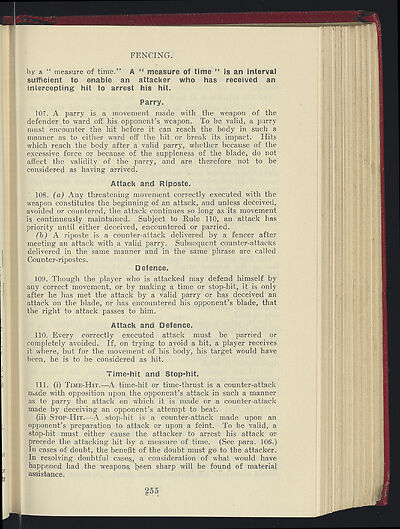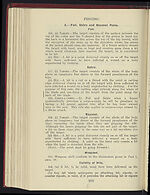1935-36
(297)
Download files
Complete book:
Individual page:
Thumbnail gallery: Grid view | List view

P
,:
t
e
)r
4
i
FENCING.
by a " measure of time." A
" measure of time " is an interval
sufficient to enable an attacker who has received an
Intercepting hit to arrest his hit.
Parry.
107. A parry is a movement made with the weapon of the
defender to ward off his opponent's weapon. To be valid, a parry
must encounter the hit before it can reach the body in such a
manner as to either ward off the hit or break its impact. Hits
which reach the body after a valid parry, whether because of the
excessive force or because of the suppleness of the blade, do not
affect the validity of the parry, and are therefore not to be
considered as having arrived.
Attack and Riposte.
105. (a) Any threatening movement correctly executed with the
weapon constitutes the beginning of an attack, and unless deceived,
avoided or countered, the attack continues so long as its movement
is continuously maintained. Subject to Rule 110, an attack has
priority until either deceived, encountered or parried.
(b) A riposte is a counter-attack delivered by a fencer after
meeting an attack with a valid parry. Subsequent counter-attacks
delivered in the same manner and in the same phrase are called
Counter-ripostes.
Defence.
109. Though the player who is attacked may defend himself by
any correct movement, or by making a time or stop-hit, it is only
after lie has met the attack by a valid parry or has deceived an
attack on the blade, or has encountered his opponent's blade, that
the right to attack passes to him.
Attack and Defence.
110. Every correctly executed attack must be parried or
completely avoided. If, on trying to avoid a hit, a player receives
it where, but for the movement of his body, his target would have
been, lie is to be considered as hit.
Time-hit and Stop-hit.
ill. (i)
T
IME-
H
IT.
—A time-hit or time-thrust is a counter-attack
made with opposition upon the opponent's attack in such a manner
as to parry the attack on which it is made or a counter-attack
made by deceiving an opponent's attempt to beat.
(ii)
S
TOP-
H
IT.
—A stop-hit is a counter-attack made upon an
opponent's preparation to attack or upon a feint. To be valid, a
stop-hit must either cause the attacker to arrest his attack or
precede the attaching hit by a measure of time. (See para. 106.)
In cases of doubt, the benefit of the doubt must go to the attacker.
In resolving doubtful cases, a consideration of what would have
happened .had the weapons been sharp will be found of material,
assistance.
?55
,:
t
e
)r
4
i
FENCING.
by a " measure of time." A
" measure of time " is an interval
sufficient to enable an attacker who has received an
Intercepting hit to arrest his hit.
Parry.
107. A parry is a movement made with the weapon of the
defender to ward off his opponent's weapon. To be valid, a parry
must encounter the hit before it can reach the body in such a
manner as to either ward off the hit or break its impact. Hits
which reach the body after a valid parry, whether because of the
excessive force or because of the suppleness of the blade, do not
affect the validity of the parry, and are therefore not to be
considered as having arrived.
Attack and Riposte.
105. (a) Any threatening movement correctly executed with the
weapon constitutes the beginning of an attack, and unless deceived,
avoided or countered, the attack continues so long as its movement
is continuously maintained. Subject to Rule 110, an attack has
priority until either deceived, encountered or parried.
(b) A riposte is a counter-attack delivered by a fencer after
meeting an attack with a valid parry. Subsequent counter-attacks
delivered in the same manner and in the same phrase are called
Counter-ripostes.
Defence.
109. Though the player who is attacked may defend himself by
any correct movement, or by making a time or stop-hit, it is only
after lie has met the attack by a valid parry or has deceived an
attack on the blade, or has encountered his opponent's blade, that
the right to attack passes to him.
Attack and Defence.
110. Every correctly executed attack must be parried or
completely avoided. If, on trying to avoid a hit, a player receives
it where, but for the movement of his body, his target would have
been, lie is to be considered as hit.
Time-hit and Stop-hit.
ill. (i)
T
IME-
H
IT.
—A time-hit or time-thrust is a counter-attack
made with opposition upon the opponent's attack in such a manner
as to parry the attack on which it is made or a counter-attack
made by deceiving an opponent's attempt to beat.
(ii)
S
TOP-
H
IT.
—A stop-hit is a counter-attack made upon an
opponent's preparation to attack or upon a feint. To be valid, a
stop-hit must either cause the attacker to arrest his attack or
precede the attaching hit by a measure of time. (See para. 106.)
In cases of doubt, the benefit of the doubt must go to the attacker.
In resolving doubtful cases, a consideration of what would have
happened .had the weapons been sharp will be found of material,
assistance.
?55
Set display mode to:
![]() Universal Viewer |
Universal Viewer | ![]() Mirador |
Large image | Transcription
Mirador |
Large image | Transcription
| Games and sports in the army > 1935-36 > (297) |
|---|
| Permanent URL | https://digital.nls.uk/248712231 |
|---|
| Description | 'Games and Sports in the Army' was an annual publication produced by the British War Office between the 1930s and 1960s. This included the Second World War. It outlines the rules and regulations for games and sports played by members of the armed forces. It features names and photographs of team members, and examples of contemporary advertising. |
|---|---|
| Shelfmark | GWB.52 |

